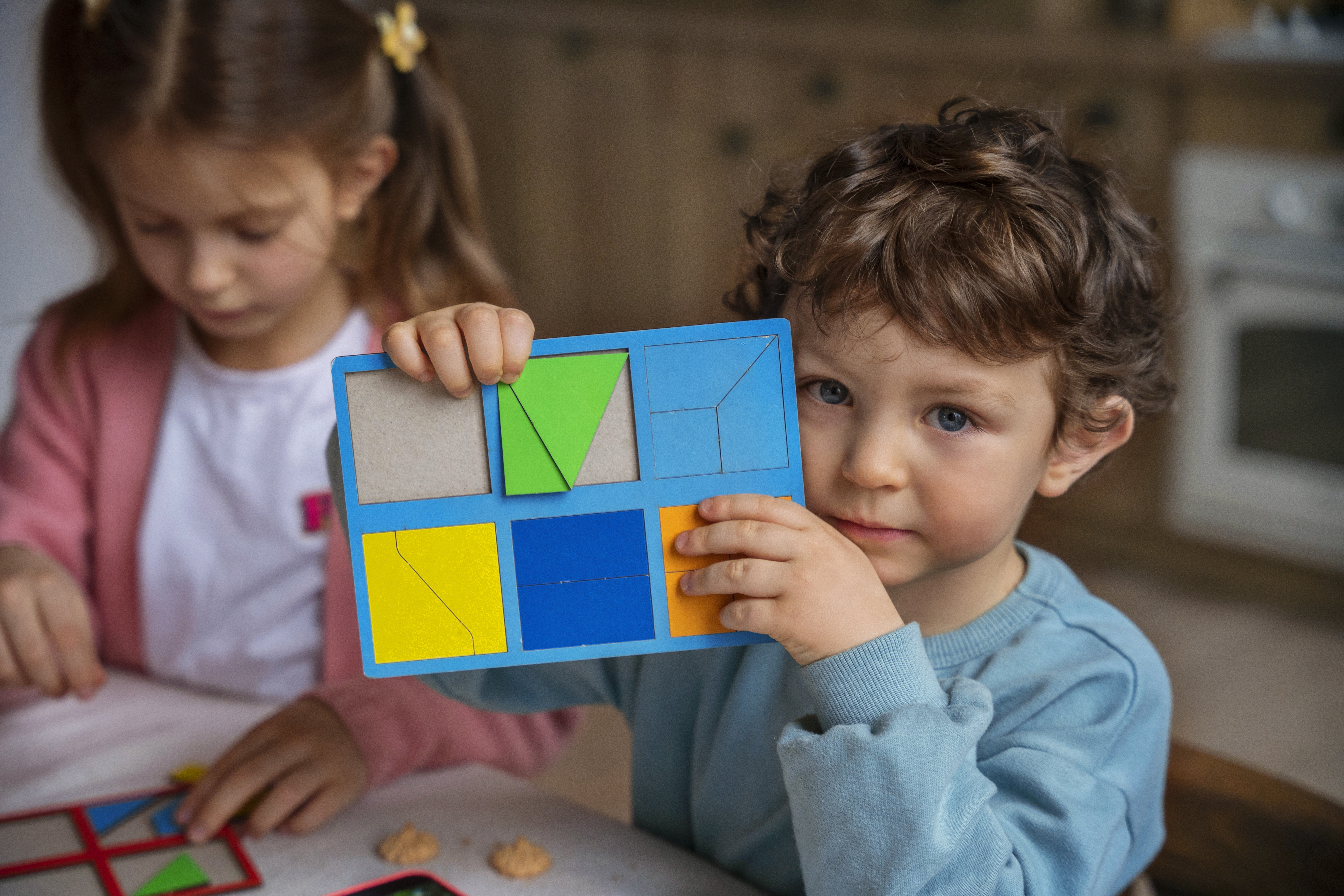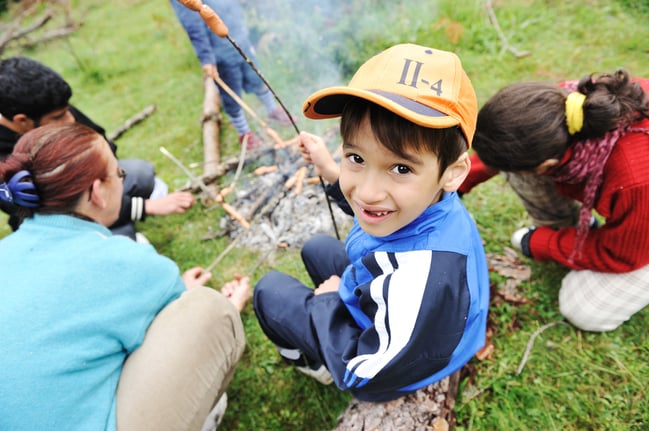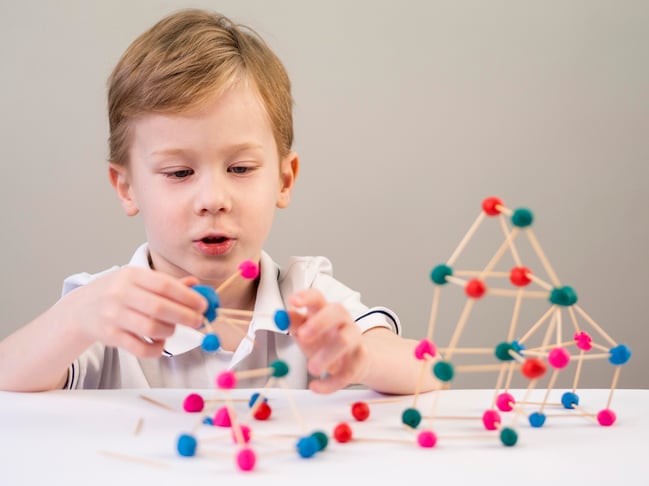
Cognitive Development
Older Preschoolers (45 to 60+ months)
Component and Developmental Indicators
Older Preschoolers (45 to 60+ months)
Component and Developmental Indicators
Developmental Indicators
CD Goal-1: Through their explorations, play, and social interactions, children use their senses to discover and construct knowledge about the world around them.
![]()
![]()
![]()
Distinguish appearance from reality (the person behind a mask is still the same person; recognize that a make-believe story was not real).
![]()
Organize and use information through matching, grouping, and sequencing.
CD Goal-2: Through their explorations, play, and social interactions, children recall information and apply it to new situations and problems.
![]()
Demonstrate their ability to apply knowledge experiences to new situations.
![]()
Describe past events in order, including details or personal reactions.
![]()
Describe how a past event relates to something happening currently or in the future (“We found worms at Grandpa’s, too!”).
![]()
Make predictions about what will happen and explain their thinking.
![]()
Try to solve problems they have solved in the past in new ways, using what they have learned.
![]()
Introduce detailed or complex ideas or actions into play, based on previous knowledge or experience.
![]()
Use reasoning to come to conclusions (including conclusions regarding cause and effect) about familiar situations and materials, based on information gathered with their senses.
CD Goal-3: Through their explorations, play, and social interactions, children demonstrate the ability to think about their own thinking: reasoning, taking perspectives, and making decisions.
![]()
Compare differences between pretend and real experiences, use language to identify pretend or make-believe situations (“That’s a pretend story.”).
![]()
Express understanding that others may have different thoughts, beliefs, or feelings than their own (“I like ketchup and you don’t.”).
![]()
Use language to describe their thinking processes with adult support.
![]()
Explain how they draw conclusions based on evidence they have gathered.
Developmental Indicators
CD Goal-4: Through their explorations, play, and social interactions, children count with understanding and use numbers to tell how many, describe order, and compare.
![]()
Count to 20 by ones with increasing accuracy.
![]()
Look at a group of up to 5 objects and quickly see and say or sign the number of objects.
![]()
With guidance and support, match numerals 1-5 to sets of objects.
![]()
Count the number of items in a group of up to 10 objects and know that the last number tells how many.
![]()
Use fingers, objects, and drawings to show adding and taking away up to 5.
![]()
Explore simple addition with support (when adding a group of 3 and a group of 2, counts, keeping track on fingers, “One, two, three...” and then counts on, “Four, five!”).
![]()
Verbally count backward from 5 using fingers and use that skill to subtract a given number (when asked how many would be left if we took 2 fingers away, counts, “Five, four, three!”).
![]()
Recognize numerals up to 10 and attempt to write them during play and daily activities.
![]()
Use and understand the terms “first” through “fifth” and “last” in their play and daily activities (“The engine is first, and the caboose is last.”).
CD Goal-5: Through their explorations, play, and social interactions, children demonstrate concepts about position, as well as identify and describe simple geometric shapes.
![]()
Create 2-dimensional shapes and 3-dimensional structures to create symmetry (are the same on both sides) or to represent real-world objects (“We are building a castle and we need a round block for the tunnel.”).
![]()
Name basic shapes, such as circle, triangle, square, and rectangle, and describe their characteristics using descriptive and geometric attributes (“That’s a triangle; it’s pointy.” “It’s a circle because it’s round.”).
![]()
Recognize that a shape remains the same shape when it changes position.
![]()
Take a shape apart to make new shapes, such as finding two triangles in a square.
CD Goal-6: Through their explorations, play and social interactions, children compare, sort, group, organize, measure, and create simple patterns using concrete objects.
![]()
Identify and use measurement tools, such as ruler, scales, measuring cups, thermometer, clock, as well as non-standard objects (measure length of shadow using shoes).
![]()
Directly compare more than two objects by size, length, or weight (“That rock is heavier than these others; I can’t lift it.”, look at three strings that are different lengths and select the longest string).
![]()
Sort a group of up to 10 objects using two attributes (color, size, shape, quantity) with increasing accuracy (sort blocks by shape and color).
![]()
Arrange up to 5 objects in order according to characteristics or attributes, such as height (put 4 water toys in order from shortest to tallest).
![]()
Sort objects onto a large graph according to one attribute, such as size, shape, or color and name the category that has the most, least.
CD Goal-7: Through their explorations, play, and social interactions, children use mathematical thinking to ask questions and solve problems.
![]()
Seek answers to questions during play and daily activities using an increasing variety of mathematical strategies.
![]()
Use observation and counting with increasing accuracy to answer questions such as “How many do we need?” and “How many more do we need?” during play and other daily activities (count new children to see how many more plates are needed for snack, return extra drinks to cooler at picnic to arrive at the correct number).
![]()
Use drawing and concrete materials to represent an increasing variety of mathematical ideas (draw shapes to represent pattern, stack differently colored blocks to represent classmates’ answers to a survey question).
![]()
Begin to explain how a mathematical problem was solved (“I saw that there was always a blue flower after a red flower, so I knew to put a blue one next.” “I counted four friends who didn’t have cookies, so I got four more.”).
![]()
Gather mathematical information (quantity, measurement of objects, etc.) to answer questions of interest.
Developmental Indicators
CD Goal-8: As a result of their explorations and participation in simple investigations through play, children observe, describe, and demonstrate respect for living things, the environment, and the physical world.
![]()
Demonstrate respect, wonder and appreciation for the environment by participating in activities that help to care for the environment. With support explain that their actions and actions of others can change the environment (gathering cans for recycling, planting trees).
![]()
Take responsibility for the care of living things (independently feed pet as daily chore, water plant when leaves drop, help weed vegetable garden).
![]()
Describe basic things plants and animals need to live and grow (sunlight, water, food). Identify changes that take place over time.
![]()
Collect items from nature (rocks, leaves, insects) and classify them using physical characteristics (color, size, shape, texture).
![]()
Provide simple rationale for future movement and speed of an object based on past experience (“Last time I made the ramp really high the marble went really fast.”).
![]()
Observe and use words to describe physical changes and their possible causes, such as solid turning to liquid.
![]()
Sort objects or materials by attributes and describe the attributes used to sort (size, color, shape, sound).
![]()
Notice and describe weather conditions, position of the sun and moon at different times, and seasonal changes.
CD Goal-9: As a result of their explorations and participation in simple investigations through play, children demonstrate their ability to use scientific inquiry by observing, manipulating objects, asking questions, making predictions, and developing generalizations.
![]()
Represent learned scientific explorations through drawing, 3-D models, diagrams, movement, or other methods.
![]()
Identify the five senses as ways they can learn more about the world and uses their senses to do so.
![]()
Use an increasing variety of tools to investigate the world around them, solve problems, and complete tasks, extending what they can observe and do through their senses alone (measuring tools, magnifying glasses, balance, prism, droppers).
![]()
Compare objects, materials, and phenomena by observing and describing their physical characteristics.
![]()
Ask questions and identify ways to find answers (look in a book, use the computer, try something and watch what happens).
![]()
Make predictions, providing a rationale based on past experiences and then carry out simple investigations to test their predictions. Gather data and communicate simple conclusions (with adult support, chart predictions of a sink and float experiment and draw on large paper).
![]()
Follow a simple visual plan or model to construct something new.
![]()
Adjust their constructions or creations to improve function, stability, or appearance.
![]()
Use scientific process words (predict, experiment, compare, measure) and scientific content words (plant, animal, magnet, weather) in discussions during science experiences.
![]()
Use the computer and other technology, if available, to explore how their actions can cause an effect.
Developmental Indicators
CD Goal-10: Through their explorations, play, and social interactions, children demonstrate an understanding of relationships, roles, and what it means to be a participating member of their families and the diverse groups/communities they belong to.
![]()
Talk about a wide circle of family members and other people important in their lives, their relationships to each other, and their shared experiences.
![]()
Adopt roles of multiple family and community members during dramatic play, using props, language, and actions in a way that demonstrates their understanding of the roles.
![]()
Identify themselves as individuals and as belonging to a family, as well as other groups such as their preschool class or faith community).
![]()
View themselves as contributing members of various groups with both rights and responsibilities (share, take turns, follow rules, take responsibility for simple jobs).
![]()
Participate in creating and following expectations/rules and routines.
![]()
Demonstrate confidence in expressing individual opinions and thoughts, while respecting those of others.
CD Goal-11: Through their explorations, play, and social interactions, children identify and demonstrate appreciation of similarities and differences between themselves and others.
![]()
Name several similarities and differences between themselves and others as well as benefits of those similarities and differences.
![]()
Show acceptance of differences through exploration of varying customs and traditions, past and present (how people dress, how people speak, food, music, art, etc.).
![]()
Demonstrate an understanding that there are diverse families and backgrounds, and all have value (talk positively about how other children have different family structures than their own; share family traditions/routines, ask questions to learn about the traditions of others).
![]()
Demonstrate respect for the thoughts and opinions of others, even when different from their own.
Developmental Indicators
CD Goal-12: Children engage in a variety of creative activities for enjoyment and self-expression including play, visual arts, music, expressive movement, and drama.
![]()
Demonstrate enjoyment and confidence in their ability to freely plan and create artwork of their own design individually and collaboratively, including drawings, paintings, collages, and sculptures.
![]()
Describe experiences, ideas, emotions, people, and objects represented in their artwork.
![]()
Draw or build representations of familiar people, places, and new understandings from topics of study with various materials.
![]()
Plan and act out scenes based on books, stories, everyday life, and imagination alone or with others, creating and engaging in increasingly detailed and extended scenarios in their dramatic play.
![]()
![]()
Recall and imitate patterns of beat, rhythm, tempo, and dynamics of music, as they create expressive movements or participate in movement activities.
CD Goal-13: Children demonstrate an appreciation for different forms of art including visual arts, music, expressive movement, and drama.
![]()
Show appreciation for a variety of art, including that of their own culture and community, as well as others.
![]()
Participate in and use art-specific vocabulary to express ideas and thoughts about artistic creations more clearly (“We need a stage for our puppet show.”).
![]()
Demonstrate value and respect for their own artwork and that of their peers.





